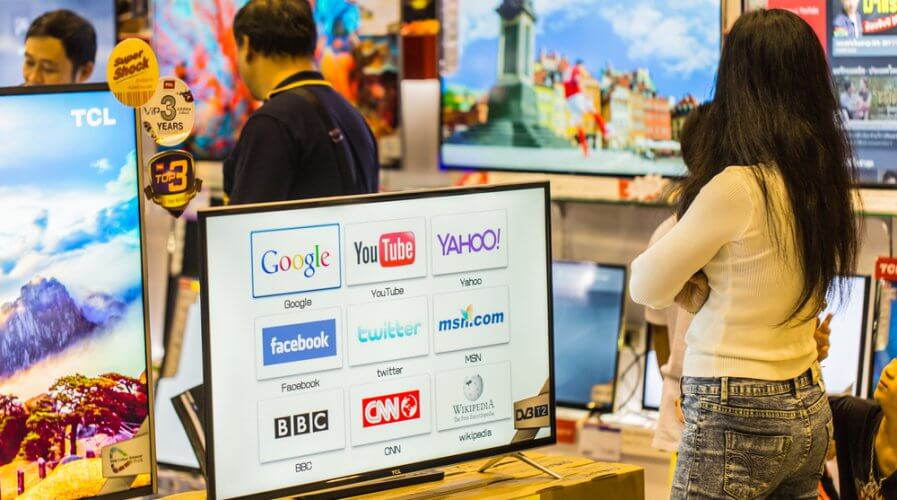
Smart TVs are making it tough for broadcasters to compete. Source: Shutterstock
How traditional broadcasters are competing with Netflix and Hulu
SUBSCRIPTION video on demand (SVoD) and video on demand platforms are taking over the world, and broadcasters have to adapt quickly.
Netflix, an SVoD platform, has close to 150 million paying subscribers worldwide. Considering that accounts are often shared by roommates, partners, and friends, the total number of individuals consuming content on the platform is close to 500 million.
And while Netflix competes for eyeballs with other SVoD players such as Hulu and Amazon, the company might soon have to offer more as traditional broadcasters are gearing up to meet customer demand.
Traditional broadcasters have a natural advantage over new-age on-demand platforms: They know what customers really like, and their understanding of their customers is more local.
In an exclusive interview with a broadcasting executive ahead of the ConnecTechAsia2019 summit, Tech Wire Asia learned about what his company — a traditional broadcaster — is doing to compete effectively.
“I think that the traditional TV culture has changed and diverged into many species.
“In the past, people used to watch TV programs of traditional TV broadcasters on TV sets. Now, the young generation watches video contents or short video clips (OTT) on mobile devices whenever and wherever they like.”
“On the other hand, people would like to watch super high definition video and very high quality surrounded audio programs on a large screen.
“Moreover, using virtual reality technology broadcasters can create more enjoyable programmes for viewers.
“Traditional TV broadcasters need to create new service and experiences by using these advanced new technologies. We’re exploring various options and will catch up soon.”
According to the executive, broadcasters seem to be are trying to combine traditional TV and new-age services to be offered via the internet.
These days, TV broadcasters in Japan provide VoD content on the OTT service for a short period of time after the TV program has aired. This practice is similar to the one followed in India, Malaysia, and other countries of the APAC, in one format or another.
Traditional broadcasters currently use the internet to distribute content in case of emergency situations or large-scale disasters to alert people and help them take necessary action to protect themselves and their families.
In the future, the broadcaster hopes to offer regular content as well.
“Traditional broadcasters are preparing OTT services and live streaming content that is the same as the on-aired program with an aim to catch-up with new-age content providers within Japan to give the service on the internet not only in an emergency situation but also in normal situations.”
To the outsider, offering broadcast video via the internet might not sound like a lot of work, but it is. It’s a process that technology is helping simplify — and traditional broadcasters have to play catch up because they’re not digital natives like many of their competitors.
Traditional broadcasters are actually also exploring other technologies to boost efficiencies and improve the experience they provide to their customers.
“We are trying to develop interesting systems using cutting-edge technologies such as artificial intelligence (AI), big data, and analytics to gather and edit news footage effectively.
“For example, we are developing and using a system that can create subtitle for interviews automatically.”
What the broadcast executive is talking about in terms of subtitling is something Google has spent an incredible amount of time perfecting for its video platform YouTube.
However, the technology isn’t something many broadcasters can boast of. If any traditional broadcaster perfects it soon, it might be a leader in the region’s broadcast market in coming months.
Although most broadcasters are exploring new ways to go digital, it seems as though not many of them have been able to really push beyond using social media to promote programmes.
In the coming months, broadcasters are expected to do more with digital.
Broadcast experts from in Japan as well as across the APAC believe that exciting new formats will be created by traditional players soon — in a bid to compete with Netflix and the likes more effectively.
Will their efforts pay off? Only time will tell.
READ MORE
- Ethical AI: The renewed importance of safeguarding data and customer privacy in Generative AI applications
- How Japan balances AI-driven opportunities with cybersecurity needs
- Deploying SASE: Benchmarking your approach
- Insurance everywhere all at once: the digital transformation of the APAC insurance industry
- Google parent Alphabet eyes HubSpot: A potential acquisition shaping the future of CRM








